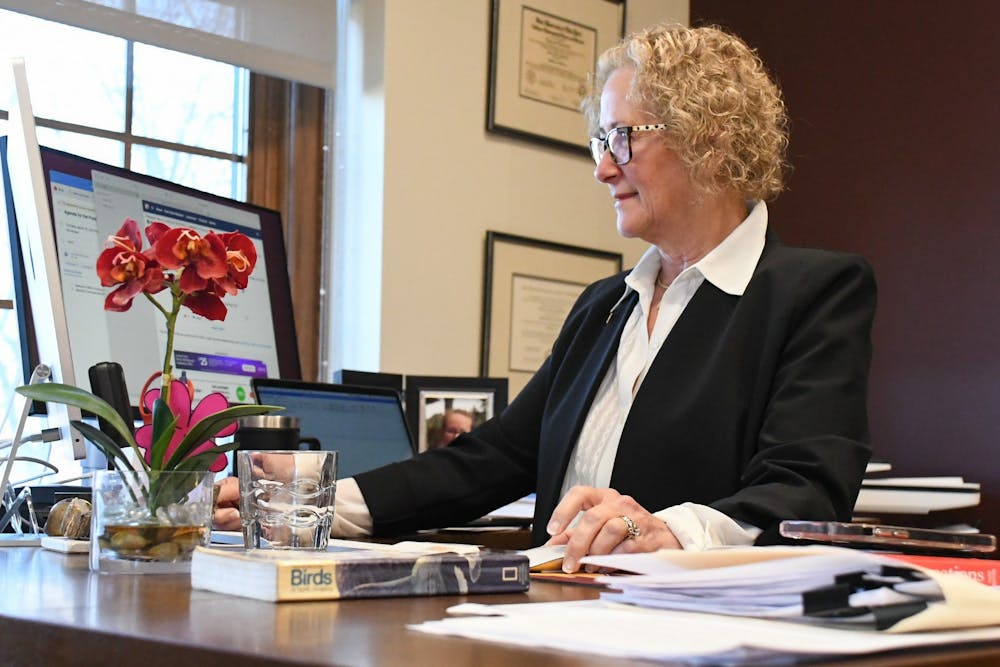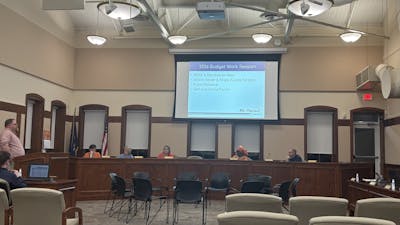Strategic planning: what it is and why your voice is important

Central Michigan University Provost Nancy Mathews works at her desk Monday, March 20 in Warriner Hall. Provost Mathews had just finished a meeting and works on sending emails.
A revised roadmap looking at everything from the cost of classes to the social trends is under way at Central Michigan University.
The Strategic Planning Team spent the past few months talking with different constituent groups across the Central Michigan University campus.
It was the first step in revamping the university’s multi-year strategic plan, which will touch on the cost of attendance, student debt, enrollment, public funding, political and social trends, university’s competitors and other things that will shape CMU’s future, according to the CMU website.
Provost Nancy Mathews referred to the strategic plan as a “roadmap” and a “North Star” for the university that will set goals for the future.
“It’s a super-effective way of trying to manage your time, your efforts, your money (and) to support a common vision or a common goal,” Mathews said.
What is a strategic plan?
According to the CMU website, the strategic plan “will clearly differentiate CMU in meaningful ways from other institutions across Michigan … (and) will outline a clear path to guide CMU forward using SMART goals.”
CMU's previous strategic plan, which expired at the end of 2022, was a five-year plan. Mathews said she would prefer for the new plan to last 10 years.
The strategic plan is also made so the university can adjust under different unpredictable circumstances, Mathews said, like the COVID-19 pandemic.
“(The pandemic) absolutely affected everything from budget to enrollment to faculty teaching the class,” Mathews said. “It made everything operate in a different way.”
Mathews said the affects of the pandemic will still be noticed in the new strategic plan. For example, she said, CMU will now be offering more mixed-modality courses.
The definition of a "student" has changed as well, Mathews said.
“The pandemic caused a lot of working people who maybe don’t have degrees to think about retooling their careers and coming back for degrees,” Mathews said.
That’s why the the strategic plan will be considering new, more flexible realities, she said.
After the strategic planning committee creates the general structure of the plan, members will overview it using “scenario planning,” which means seeing how the plan works under different situations, she said.
What does the process of creating a Strategic plan look like?
The team spent February and March in what Mathews called the “data acquisition period.” The team reached out to different demographic groups in the university to how they envision the university’s future.
According to CMU’s website, the Strategic Planning Team, chaired by Mathews, will then report to the Strategic Planning Executive Committee, which will present the plan to the CMU Board of Trustees.
The Strategic Planning Team is divided into three groups: facilitators, distillers and writers, Mathews said. She said facilitators, about eight people, met with constituent groups and asked three questions:
- How can CMU differentiate itself from competitors?
- How can CMU adapt to changing needs of students?
- How can CMU positively impact communities, employers’ expectations and social needs?
The team met with at least 20 groups and now will process the feedback and findings into draft recommendations
"I was really proud of our efforts to reach the second- and third-shift workers; staff members that you don’t see during the daytime," Mathews said.
Facilitators also reached out to retired faculty and staff, community members, members of the Saginaw Chippewa Indian Tribe, alumni, faculty and students, she said.
Mathews said the facilitators have already surveyed over 20% of the university’s population.
“What I’m more concerned about is getting as many people as possible to respond and to make sure they know they’ve been invited,” Mathews said.
Student Government Association President Taylor Idema said a team of facilitators visited the SGA General Board meeting on Monday, March 13. She said the team gave a presentation about the strategic plan and asked the same questions to get student perspectives. Idema said around 100 students participated in the meeting.
“It was really cool to hear what students had to say,” Idema said. “Also, it was really cool to give students that opportunity to voice their opinions and thoughts.”
Prior to that, the Strategic Planning Team also talked to the SGA cabinet, Idema said.
This year, Idema said, administrators are doing a better job at showing up at events and listening to students. She praised university administrators for coming to the SGA townhall this year.
“I think if the administrators really want to understand the CMU students in 2023, then they need to be with students … show up for students, show up in spaces that students are,” she said.
Idema said it is important that students voices have access to be represented.
“I think that transparency is important,” Idema said. “I think that ensuring and putting in place those means of communication (is) … important.”
“We need (students) on board,” Mathews said. “We need your ideas.”
Why are student voices important?
Mathews said students bring to light a university’s trends and perspectives, she said.
“CMU is here to serve students,” Idema said. “I think when it comes to looking at the direction we want CMU to grow … students are uniquely situated to speak on that topic.”
Idema said students are “living, breathing, going to class and working at CMU,” and they should speak up on their questions, comments or concerns.
“(Students) are the next generation of leaders and engaged citizens … participants in this democracy,” Mathews said.
Idema said students will “bring to the table” ideas and unique perspectives on different issues, as well as opinions that might be missing in the narrative. She said the more perspectives are heard, the better we are as a university and as a society.
“Students are the life of the university,” she said.
The future of the strategic planning
After facilitators gather the necessary data, the second group from the strategic planning team — the distillers — will be looking at the data and identifying major themes, she said. Once the distillers finish, the writers will craft language around these themes, which will become an overarching plan.
The final step is the creation of the SMART goals, that are “action items written underneath each of those themes,” Mathews said. For example, if the theme was enhancing students’ experience through engaged learning, then the SMART goal might have been increasing fundraising for supporting students’ internships.
After facilitators get the information and distillers sort it out, the Strategic Planning Team will return in late April or early May to ask the constituent groups if the team has captured what they said correctly.
Then the plan goes to the Strategic Planning Committee she said. According to the CMU’s website, the committee consists of:
· Todd Anson – Trustee (Co-Chair)
· Sharon Heath – Trustee (Co-Chair)
· Robert Davies – President
· Tracy Davis – Academic Senate Chair/Faculty Member
· Mary Jane Flanagan – Chief of Staff to the President
· Joe Garrison – Liaison to the President for Strategic Planning/Executive Director – Financial Planning and Budgets
· Nancy Mathews – Executive Vice President/Provost
· Evan Montague – Executive Director – Student Success and Academic Advising and Assistance
· Sarah Opperman – Alumni Leader
The committee will meet in August, review the plan and offer it to the Board of Trustees on its first meeting next year, Mathews said.
To give feedback and learn more about the strategic planning information sessions, visit CMU’s website.






